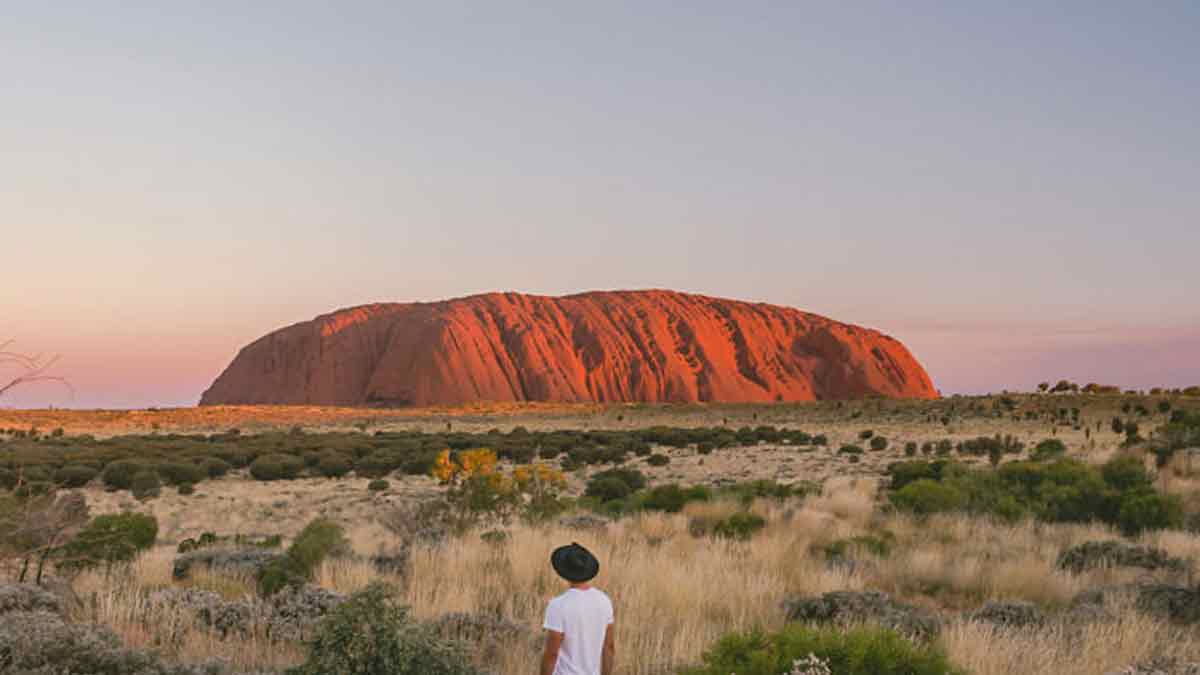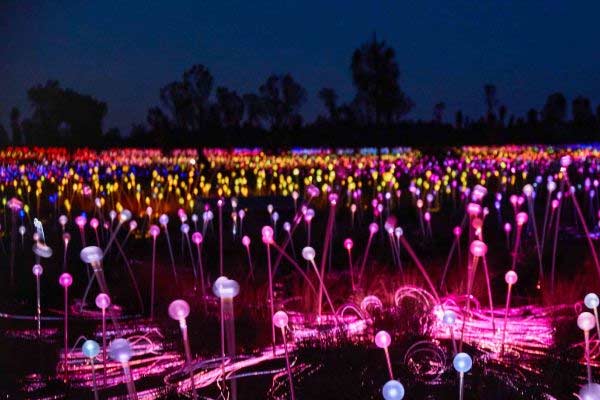Sitting at the heart of Australia’s breathtaking outback, Uluru (formerly known as Ayer’s Rock) is a truly unforgettable sight, a 348-metre high monolith that rises majestically from the surrounding desert like an alien edifice.
It serves as the centrepiece of the World Heritage-listed Uluru-Kata Tjuta National Park, an area of exceptional natural beauty and deep cultural significance to the local Aboriginal people, the Anangu. Thousands of travellers flock here every year to experience it for themselves.
There are so many ways to see Uluru, and all the otherworldly sights nearby. Here’s our complete guide to it all so you won’t miss anything.
How to get to Uluru
The red centre of Australia is big. This means the best way to reach Uluru at its heart is to take a tour from Alice Springs, which is the nearest large town despite being some 460km away.
For example this coach will travel from Alice Springs to Uluru (Ayers Rock). Then you get to enjoy the rugged desert landscapes and the scenic views as you pass through the MacDonnell Ranges too.
If you’re in a hurry, you can fly to Alice Springs or directly to Uluru in a few hours from most major Australian cities. Longer tours down from Darwin, the Northern Territory’s capital city, are also available.
The Best Ways to Experience Uluru
Okay, let’s start with what most consider the main event of the red centre – Uluru itself. The towering rock has been awaiting your visit for around 600 million years, so the least you can do is make the most of it while you’re there.
Uluru walking tours
Many visitors choose to walk around the base of Uluru, so they can get acquainted with the shapely contours of the imposing monument at their own pace. Along the way you’ll find peaceful waterholes, often formed by rain streaming down the rock, and hidden caves to peek inside. There are numerous walking trails around Uluru, most of which are wheelchair accessible.
Guided walking tours of Uluru are available, many with Indigenous guides who will share Dreamtime stories passed down by generations, take you to ancient rock art sites, and teach you about the surprisingly abundant wildlife and plant life that calls the area home.
Choosing to walk around Uluru instead of climbing it means you are respecting the wishes of the Anangu people.
From October 2019, visitors will be banned from climbing it altogether.
Uluru camel tours
Exploring the red sands of Central Australia on camel back is the ultimate desert experience. Settle back into your saddle and let these hardy animals do the work as you tour the base of Uluru feeling like a pioneer. Short rides are available if you just want a taste of the experience, or you can saddle up for longer tours that thoroughly roam the area.
The best time to take an Uluru camel tour is at sunrise or sunset, so you can witness how the fading light shifts colours across the rock (more on this later!).
Cycling around Uluru
Cycling around the base of Uluru is a great way to see as much of it as possible in a shorter time. The 15km cycling track can comfortably be completed in under three hours, including plenty of time to stop for a break by a tranquil waterhole.
Bicycles can be hired from Outback Cycling at the Uluru Kata-Tjuta Cultural Centre, with a bus transfer option to get you to the rock. Adult hire costs $50 for three hours and includes a helmet (safety first!).
Uluru Segway tours
If walking or cycling seems like too much effort, and a camel far too old-fashioned, an Uluru tour on Segway might be for you. These two-wheeled personal transports offer an easy and fun way to traverse the base of Uluru without needing to break a sweat.
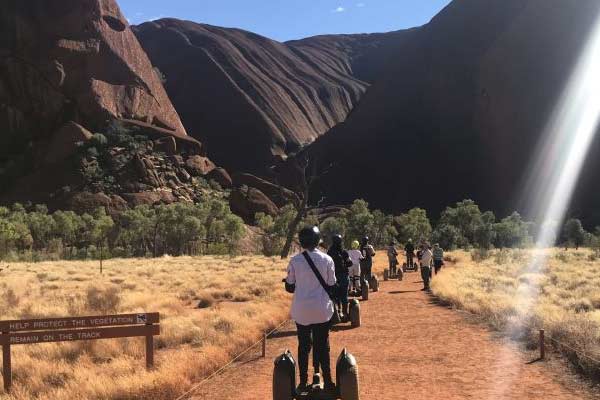
Tours like this one are fully guided, and groups are kept small to ensure an intimate experience.
Skydiving over Uluru
You’ve got up close and personal with Uluru on the ground, so now it’s time to get a fresh perspective – from the sky! Skydiving over Uluru is guaranteed to get your adrenaline pumping. The plane takes you 12,000 feet above the national park, providing unparalleled views across the region. Once you leap out, those views will rapidly get closer!
After the thrilling freefall, your parachute launches to give you five minutes of euphoria as you drift back to the desert floor, heart pounding the entire way.
All skydives are tandem jumps, so you’ll be connected to an instructor for the entire duration, making sure you always feel safe and secure.
Uluru at sunset
By the evening, you’ll be weary enough to gladly sit down, relax, and watch the sunset. It’s during these times that the colours on the rock famously shift from ochre brown to burnished orange to intense, glowing red, producing a natural light show unlike anything else in the world. Sunrises are similarly spectacular, if you don’t mind getting up early.
There are five viewing areas built specifically for the best views of Uluru, so bag yourself a good spot and get your camera ready to capture the magic.
Field of Light at Uluru
After the sun has set, and Uluru is thrown into stark silhouette against the night sky, it’s time for the dazzling Field of Light to illuminate the desert with its pulsing rhythms of iridescent radiance.
This exhibition is the brainchild of internationally celebrated artist Bruce Munro. The lights, swaying like alien flora, cover the same space as seven football fields and appear to bring the whole desert flushing to life.
It’s recommended that you book your Field of Light experience before arriving at Uluru, as spaces are limited, and the exhibition site can’t be accessed without a booking.
Kata Tjuta
Also known as the Olgas, Kata Tjuta is a lesser-known but no less spectacular domed rock formation located only 40km from Uluru. Despite its lower profile, Kata Tjuta and its surrounds are every bit as delightful to explore as its more famous sibling, and offers the same jaw-dropping sunrises and sunsets.
Walpa Gorge walk
There are numerous walking tracks around Kata Tjuta to suit all fitness levels, from short strolls to longer, more strenuous treks. The Walpa Gorge Walk is one of the more relaxed paths, a rocky track rising gently through a gorge that steers you past rare plants and into a grove of bright spearwood shrubs. The sheer walls of the gorge ensure a refreshing breeze and some shelter from the sun.
The walk takes around an hour to complete.
Valley of the Winds walk
If you’re feeling up for a harder walk, the three-hour Valley of the Winds trek around Kata Tjuta will soon reward you with breathtaking views of the beautiful rock domes. The higher difficulty and length (around three hours) of the walk means fewer visitors attempt all of it, so you might eventually find yourself blissfully alone in this extraordinary environment. Make sure to snap a few selfies at the two lookouts along the way!
It’s recommended that you begin the walk early in the morning when temperatures are cooler. This also gives you a better chance of spotting kangaroos and other local wildlife.
Combine Kata Tjuta Sunrise & Valley of the Winds in one by joining this morning 2-3 hour guided tour.
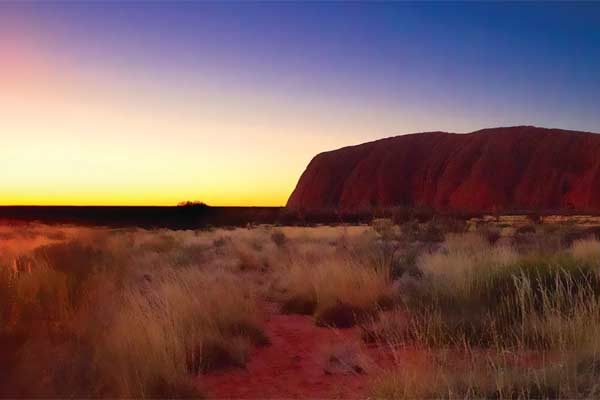
Kings Canyon
Lying only a three-hour drive from Uluru, Kings Canyon is yet another astonishing natural wonder, its 100-metre-high sandstone walls permeated with crevices filled with forests of palm trees and offering desert views that seem to stretch forever across Watarrka National Park.
Although it can be visited as a day trip destination, Kings Canyon has plenty to offer if you choose to stay for longer. There are numerous walks to suit different fitness levels. The most popular is the Rim Walk, known for its striking views of the Canyon rim, the weathered domes of ‘The Lost City’, and the ‘Garden of Eden’ – a permanent waterhole lush with greenery that stands in stark contrast to the orange rock formations around it.
Depending how adventurous you’re feeling, there are also options to explore Kings Canyon on camelback and quad bike,
or to take this helicopter tour and see it all from the sky. The views are spectacular.
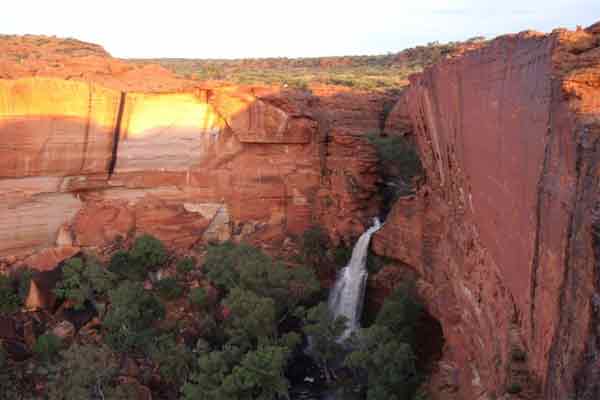
Food and drink around Uluru
There are loads of reasons to stay close to Uluru after night has fallen. You’re going to be hungry after a day of adventure, and the Sounds of Silence dinner package offers sumptuous gourmet meals eaten against the backdrop of Uluru and under the blazing stars. You will never find a more dramatic dinner setting. You can also opt for the Tali Wiru package, where every dish is based on native delicacies.
If you’re not in the mood for anything quite so formal, you could join a Bush Tucker Journey to learn more about the Indigenous lifestyle and how they ate. You’ll have the chance to sample native animals, fruits, insects, seeds, and more. It’s pretty much a guarantee you won’t have tasted anything like it before.
And if you really want to keep it simple, there are loads of spots to set up your own barbecue and cook up a storm!
Camping and stargazing
There are several camping grounds around Uluru where you can set up a tent, park a camper van, or hire a cabin for the night. This offers the once-in-a-lifetime experience of sleeping in the middle of the Australian outback and will leave you bedazzled by the canopy of stars that gleam impossibly brightly overhead.
In the morning, you’ll be in the perfect spot to watch the sun rise over Uluru or Kata Tjuta, before heading out early to beat the crowds for another day of adventure in this incredible location.
FAQ’s

Co-Founder of the OFT Blog. Mother of 2 who disguises as a 9 to 5 finance professional on most days. She loves to travel, is an amateur website builder and cook. And given her day job, she loves travel planning and saving money. Follow along!


